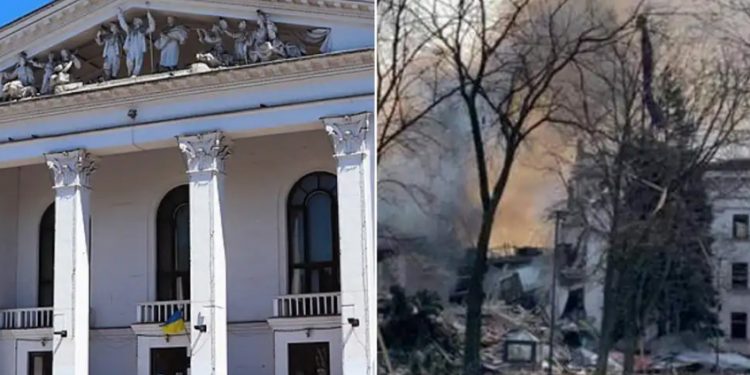Kyiv: Ukrainian authorities in the besieged ruins of Mariupol said Friday that about 300 people died when a Russian airstrike blew up a theatre where hundreds of civilians were sheltering. They said it was a catastrophic loss of civilian life which, if confirmed, is likely to further crank up pressure on Western nations to step up military aid.
In a vain attempt to protect those inside the grand, columned theatre from missile and airstrikes that Russia has rained down on cities, an enormous inscription reading ‘CHILDREN’ in Russian was posted outside the building and was visible from the air.
For days, the government in the battered port city was unable to give a casualty count for the March 16 attack. The post on its Telegram channel Friday cited eyewitnesses. It was not immediately clear whether emergency workers had finished excavating the theatre ruins or how witnesses arrived at the horrific figure of lives lost.
Still, the emerging picture of gruesome casualties could refocus attention on the refusal thus far of countries from the NATO alliance to supply warplanes or fly patrols over Ukraine’s airspace. The country’s embattled president has repeatedly pleaded for those measures to protect against such strikes.
Soon after the attack, Ludmyla Denisova, the Ukrainian Parliament’s human rights commissioner, said more than 1,300 people had been inside, many whose homes were destroyed in Russia’s siege of the city. The building had a relatively modern basement bomb shelter, and some survivors did emerge from the rubble after the attack.
The new reported death toll came a day after US President Joe Biden and other leaders promised after meeting in Brussels that more military aid for Ukraine is coming. But they stopped short of providing heavy weaponry that Ukrainian President Volodymyr Zelenskyy wants. NATO nations fear that providing planes, tanks and other hardware that Zelenskyy says is urgently needed could increase the risk of them being drawn into direct conflict with Russia.
But the US and the European Union did announce a move to further squeeze Russia: a new partnership to reduce Europe’s reliance on Russian energy and slowly squeeze off the billions of dollars the Kremlin gets from sales of fossil fuels.
Despite the efforts to target Russia’s economy to push the Kremlin to change course, the misery for civilians grows ever more acute in cities that, day-by-day, increasingly resemble the ruins that Russian forces left behind in previous campaigns in Syria and Chechnya.
Those who can are trying to flee, emptying out their cities. In relentlessly shelled Kharkiv, mostly elderly women came to collect food and other urgent supplies. In the capital of Kyiv, ashes of the dead are piling up at the main crematorium because so many relatives have left, leaving urns unclaimed.
Meanwhile, the vulnerable — the elderly, children and others unable to join millions of refugees heading westward — face food shortages in a country once known as the breadbasket for the world.
Fidgeting with anticipation, a young girl in Kharkiv watched intently this week as a volunteer’s knife cut through a giant slab of cheese, carving out thick slices — one for each hungry person waiting stoically in line.






































